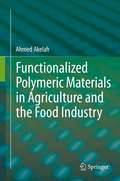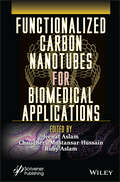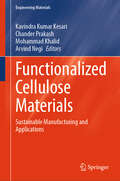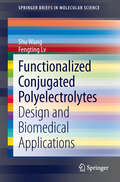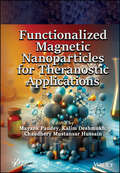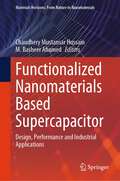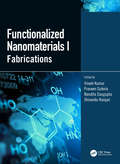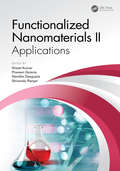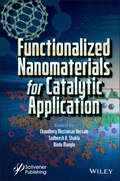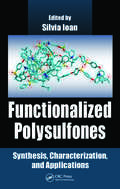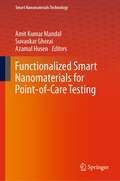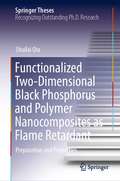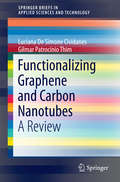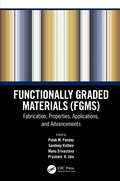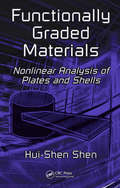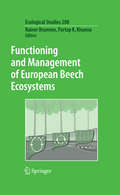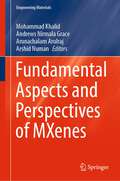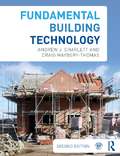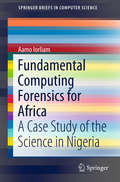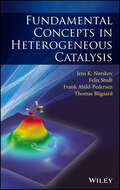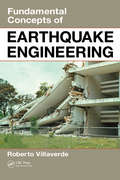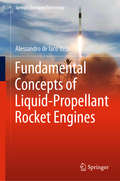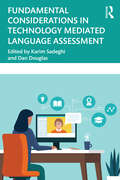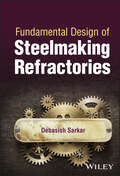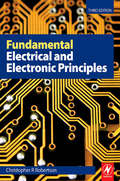- Table View
- List View
Functionalized Polymeric Materials in Agriculture and the Food Industry
by Ahmed AkelahThe purpose of this book will be to demonstrate 1) the newly developed method of using reactive functionalized materials in agriculture to solve the economic and public health problems associated with using conventional agrochemicals; and 2) new technology aimed at achieving the greening of chemistry to meet appropriate environmental standards in both agriculture and industrial foodstuffs production. More specifically, the book will accomplish this goal by addressing 3 key issues in the field: 1) the production of reactive functionalized materials with enhanced properties that offer a major opportunity to overcome the disadvantages of using traditional materials; 2) the applications of functionalized materials in agriculture for the purpose of solving the economic and the environmental pollution problems associated with the uses of conventional agrochemicals; and 3) the contribution of polymers in solving problems associated with conventional procedures of food growth and processing, including those used in the dairy industry, sugar and fruit juices, beer and wine production, nutritive and nonnutritive food additives, and in food protection.
Functionalized Carbon Nanotubes for Biomedical Applications
by Chaudhery Mustansar Hussain Jeenat Aslam Ruby AslamFUNCTIONALIZED CARBON NANOTUBES FOR BIOMEDICAL APPLICATIONS The book highlights established research and technology on current and emerging trends and biomedical applications of functionalized carbon nanotubes by providing academic researchers and scientists in industry, as well as high-tech start-ups, with knowledge of the modern practices that will revolutionize using functionalized carbon nanotubes. Nanotechnology suggests fascinating opportunities for a variety of applications in biomedical fields, including bioimaging and targeted delivery of biomacromolecules into cells. Numerous strategies have been recommended to functionalize carbon nanotubes with raised solubility for efficient use in biomedical applications. Functionalized carbon nanotubes have unique arrangements and extravagant mechanical, thermal, magnetic, optical, electrical, surface, and chemical properties, and the combination of these features gives them widespread biomedical applications. Functionalized carbon nanotubes are relatively flexible and interact with the cell membranes and penetrate different biological tissues owing to a “snaking” effect, therefore both the pharmacological and toxicological profiles of functionalized carbon nanotubes have gathered much attention in recent times. This book covers a broad range of topics relating to carbon nanotubes, from synthesis and functionalization to applications in advanced biomedical devices and systems. As they possess unique and attractive physical, chemical, optical, and even magnetic properties for various applications, considerable effort has been made to employ functionalized carbon nanotubes as new materials for the development of novel biomedical tools, such as diagnostic sensors, imaging agents, and drug/gene delivery systems for both diagnostics and clinical treatment. Audience The book is intended for a very broad audience of researchers and scientists working in the fields of nanomaterials, nanomedicine, bioinspired nanomaterials, nanotechnology, and biomedical application of nanomaterials.
Functionalized Cellulose Materials: Sustainable Manufacturing and Applications (Engineering Materials)
by Kavindra Kumar Kesari Chander Prakash Mohammad Khalid Arvind NegiThis book explores the innovative landscape of functionalized cellulose materials, emphasizing sustainable manufacturing practices and their wide-ranging applications. Advanced functional materials have seen extensive utilization across various sectors, including food processing, pharmaceuticals, cosmetics, electronics, textiles, environmental management, healthcare, and energy, all of which align with the Sustainable Development Goals (SDGs). These materials can be synthesized from both organic (primarily plant-based) and inorganic sources, utilizing sustainable biomass such as wheat, rice straw, wood fibers, and other renewable resources, with or without the incorporation of polymers and nanomaterials. Featuring contributions from leading international researchers, this book provides a comprehensive overview of current challenges and advances in materials science and advanced manufacturing across diverse industries, including cellulose films, aerospace, automotive, marine, and biomedical fields. It covers state-of-the-art topics such as additive manufacturing, 3D printing, bio-manufacturing, and intelligent manufacturing systems. The book highlights key innovations and practical applications of cellulose-based functionalized materials, such as hydrogels, drug delivery platforms, and biomaterials. This field continues to expand through interdisciplinary collaboration, fostering advancements in green chemistry, sustainable manufacturing practices, and materials engineering while addressing pressing challenges in sustainability and circular economy frameworks.
Functionalized Conjugated Polyelectrolytes
by Shu Wang Fengting LvFunctionalized Conjugated Polyelectrolytes presents a comprehensive review of these polyelectrolytes and their biomedical applications. Basic aspects like molecular design and optoelectronic properties are covered in the first chapter. Emphasis is placed on the various applications including sensing (chemical and biological), disease diagnosis, cell imaging, drug/gene delivery and disease treatment. This book explores a multi-disciplinary topic of interest to researchers working in the fields of chemistry, materials, biology and medicine. It also offers an integrated perspective on both basic research and application issues. Functionalized conjugated polyelectrolyte materials, which have already drawn considerable interest, will become a major new direction for biomedicine development.
Functionalized Magnetic Nanoparticles for Theranostic Applications
by Chaudhery Mustansar Hussain Kalim Deshmukh Mayank PandeyThis unique book provides a comprehensive introduction to the multifaceted realm of functionalized magnetic nanoparticles in the field of theranostics, exploring the fundamental concepts, synthesis methods, characterization techniques, and potential applications. In recent years, the intersection of nanotechnology and medicine has ushered in a new era of therapeutics and diagnostics. Among the myriad nanostructures, magnetic nanoparticles (MNPs) have emerged as versatile candidates with immense potential for theranostic applications. Their unique combination of magnetic properties and functionalization capabilities has paved the way for innovative approaches in both the diagnosis and treatment of various diseases. Understanding the synthesis, characterization, and manipulation of these MNPs is essential for harnessing their full potential in theranostics. Advances in nanotechnology have enabled precise control over their size, shape, and surface chemistry, allowing for tailored functionalities to suit specific biomedical applications. From superparamagnetic iron oxide nanoparticles (SPIONs) to magnetic nanorods and beyond, the diverse landscape of MNPs offers a rich playground for innovation. The convergence of diagnosis and therapy is facilitated by functionalized MNPs; their magnetic properties render them invaluable tools for imaging modalities such as magnetic resonance imaging (MRI), offering high-resolution anatomical and functional information for disease detection and monitoring. Simultaneously, functionalizing MNPs with targeting ligands, therapeutic agents, or stimuli-responsive moieties empowers them to actively engage in targeted drug delivery, hyperthermia, or magnetic manipulation of biological processes. This synergistic approach exemplifies the essence of theranostics—combining therapy and diagnostics to achieve personalized and precise medical interventions. The book discusses the challenges ahead, including the translation of functionalized MNPs from bench to bedside, which necessitates rigorous preclinical and clinical evaluations to ensure safety, efficacy, and biocompatibility. Moreover, the complex interplay between nanoparticles and biological systems demands a multidisciplinary approach, bridging the gap between materials science, biology, and clinical medicine. Regulatory hurdles, scalability issues, and ethical considerations further underscore the need for concerted efforts and strategic collaborations in the development and commercialization of MNP-based theranostic platforms. The readers will find that “Functionalized Magnetic Nanoparticles for Theranostic Applications” comprehensively covers the chemical, structural, and biological properties of functionalized magnetic nanoparticles for theranostic applications as well as most of the challenges. Audience This unique reference book will be of great value to materials engineers, polymer scientists, and technologists working in the electronic, electrical, and biomedical industries. It will also be of great use to graduate, postgraduate, and engineering students working in materials and polymer science.
Functionalized Nanomaterials Based Supercapacitor: Design, Performance and Industrial Applications (Materials Horizons: From Nature to Nanomaterials)
by Chaudhery Mustansar Hussain M. Basheer AhamedThis book portrays an extensive outline of “functionalized nanomaterials based supercapacitor”, including their fundamental as well as industrial-scale exploratory research. The contributed parts stretch the readers a complete report of the field of functionalized nanomaterials-based supercapacitor appropriate hypothetical standard of their structure to their execution, realization and potential application. It covers the latest system and functionalized nanomaterials for preparation, development, construction, validation and design of supercapacitor for commercial application. To best of our knowledge, there is no book available on the topic.Advanced undergraduate and graduate students can find this book a good source of knowledge and guidelines for their studies. They can find this book highly up to date, easy to use and understandable. This book is able to ease their thirst of learning of new and advanced electrochemical sensors.Moreover, the volume editors anticipate that this book is of significant interest to scientists working on the basic issues surrounding applications of nanotechnology in electrochemical sensors. Because of the multidisciplinary nature of this topic, this book attracts a broad audience including chemists, materials scientists, pharmacist, biologist and chemical engineers, who are involved and interested in the future frontiers of functionalized nanomaterials-based supercapacitor sciences and technology.Overall, this book is planned to be a reference book for researchers and scientists who are searching for new and advancement in supercapacitors sciences and technology.
Functionalized Nanomaterials I: Fabrications
by Vineet Kumar Shivendu Ranjan Nandita Dasgupta Praveen GuleriaNanomaterials contain some unique properties compared to their bulk. Their unique properties are due to the chemical nature of the material, small size, and surface functionalization. Along with control over size, the functionalization of nanomaterials also affects their compatibility to the environment and living organisms. This book provides a detailed account of nanomaterials functionalization along with a brief overview of their application. This book serves as a reference for scientific investigators including doctoral and postdoctoral scholars and undergradate and graduate students who need to have knowledge of the basics of nanomaterial functionalization, recent advancements, challenges, and opportunities in this field. This book will also provide critical and comparative data for nano-technologists and may be beneficial for industry personnel, journalists, policy makers, and the general public to help understand functionalized nanomaterials in detail and in depth. Features: This book is comprehensive and covers all aspects of functionalized nanotechnology. It describes the challenges and methods of functionalized nanomaterials synthesis for different applications. It discusses the recent findings and cutting-edge global research trends on the functionalization of nanomaterials. It emphasizes the products and market, safety, and regulatory issues of functionalized nanomaterials. It contains contributions from international experts and will be a valuable resource for researchers.
Functionalized Nanomaterials II: Applications
by Vineet Kumar Shivendu Ranjan Nandita Dasgupta Praveen GuleriaThe functionalization of nanomaterials provides them with some unique properties, making the same nanomaterial amenable for various applications by simply manipulating functional components. However, functionalized nanomaterials also face some challenges, along with some encouraging new applications in the future. This book provides a detailed account of applications of the functionalization of nanomaterials. This book can serve as a reference book for scientific investigators, including doctoral and post-doctoral scholars and undergraduate and graduate students, in context with the scope of applications of functionalized nanomaterials. It also highlights recent advances, challenges, and opportunities in the application of nanomaterials. This book will provide critical and comparative data for nanotechnologists. It may also be beneficial for multidisciplinary researchers, industry personnel, journalists, policy makers, and the common public to understand the scope of functionalized nanomaterials in detail and in depth. Features: This book covers various applications of functionalized nanomaterials. It discusses recent global research trends and future applications of functionalized nanomaterials. It highlights the need for more rigorous regulatory frameworks for the safe use of functionalized nanomaterials. It contains contributions from international experts and will be a valuable resource for researchers.
Functionalized Nanomaterials for Catalytic Application
by Chaudhery Mustansar Hussain Sudheesh K. Shukla Bindu ManglaWith the rapid development in nanotechnology, it is now possible to modulate the physical and chemical properties of nanomaterials with molecular recognition and catalytic functional applications. Such research efforts have resulted in a huge number of catalytic platforms for a broad range of analytes ranging from metal ions, small molecules, ionic liquid and nucleic acids down to proteins. Functionalized nanomaterials (FNMs) have important applications in the environmental, energy and healthcare sectors. Strategies for the synthesis of FNMs have contributed immensely to the textile, construction, cosmetics, biomedical and environmental industries among others. This book highlights the design of functionalized nanomaterials with respect to recent progress in the industrial arena and their respective applications. It presents an inclusive overview encapsulating FNMs and their applications to give the reader a systematic and coherent picture of nearly all relevant up-to-date advancements. Herein, functionalization techniques and processes are presented to enhance nanomaterials that can substantially affect the performance of procedures already in use and can deliver exciting consumer products to match the current lifestyle of modern society.
Functionalized Polysulfones: Synthesis, Characterization, and Applications
by Silvia IoanFunctionalized Polysulfones: Synthesis, Characterization, and Applications focuses on polysulfones and their derivatives, which are widely used as functional materials in the biochemical, industrial, and medical fields due to their structural and physical characteristics, such as good optical properties, high thermal and chemical stability, mechani
Functionalized Smart Nanomaterials for Point-of-Care Testing (Smart Nanomaterials Technology)
by Azamal Husen Amit Kumar Mandal Suvankar GhoraiThis book highlights the recent advancement in point-of-care testing (POCT) technologies utilizing ‘smart’ nanomaterials for the analysis of biomarkers related to disease, which includes metabolites, enzymes, proteins, nucleic acids, cancer cells and multidrug-resistant pathogen. The POCT refers to medical diagnostic tests performed near the place and time of patient care. During the recent pandemic of COVID-19, many realized the importance of affordable, rapid and accurate POCT devices and their usefulness to combat the spread of the infection. The chapters in this book describe the emergence of ‘smart’ nanomaterials with unique physical and chemical properties being utilized in POCT devices for immobilizing biorecognition elements and labels for signal generation, transduction and amplification. It showcases the applications of these smart nanomaterials and their superiority in developing point-of-care diagnostics devices in a wide range of applied fields like food industry, agriculture sector, water quality assessment, pharmaceuticals and tissue engineering. It also looks into the challenges associated and future direction of research in this promising field. This book caters as reference book for researches from the field of nanobiotechnology and biomedical sciences who are interested in the development of rapid, affordable and accurate POCT devices.
Functionalized Two-Dimensional Black Phosphorus and Polymer Nanocomposites as Flame Retardant: Preparation and Properties (Springer Theses)
by Shuilai QiuThis thesis details the novel preparation methods and the improved properties of two-dimentional (2D) black phosphorene (BP) and the polymer nanocomposites. Various surface treatment methods are used, and through these designs, better mechanical, thermal and flame retardant properties are achieved for these functionalized materials, thus reducing the fire risk of the polymer composite system.
Functionalizing Graphene and Carbon Nanotubes
by Filipe Vargas Ferreira Luciana De Simone Cividanes Felipe Sales Brito Beatriz Rossi Canuto Menezes Wesley Franceschi Evelyn Alves Nunes Simonetti Gilmar Patrocínio ThimThis book compiles all current information on the different types of functionalization of carbon nanotubes (CNTs) and graphene, both covalent and non-covalent. The book starts with a general overview of the synthesis, characterization and application of functionalized CNTs and graphene. Special attention is dedicated to the characterization of functionalized materials, a topic rarely addressed on the literature. The authors provide a comparison between the functionalization of these two types of carbon materials.
Functionally Graded Materials (FGMs): Fabrication, Properties, Applications, and Advancements
by Pulak M. Pandey, Sandeep Rathee, Manu Srivastava, and Prashant K. JainThe science and study of functionally graded materials (FGMs) have intrigued researchers over the last few decades. Their application has the capability to produce parts with unmatched properties which are virtually impossible to obtain via conventional material routes. This book addresses various FGM aspects and provides a relevant, high-quality, and comprehensive data source. The book covers trends, process classification on various bases, physical processes involved, structure, properties, applications, advantages, and limitations. Emerging trends in the field are discussed in detail and advancements are thoroughly reviewed and presented to broaden the spectrum of FGM applications. This reference book will be of interest to scholars, researchers, academicians, industry practitioners, government labs, libraries, and anyone interested in the area of materials engineering.
Functionally Graded Materials: Nonlinear Analysis of Plates and Shells
by Hui-Shen ShenPut a New Class of Structural Composites to UseReal Solutions for Predicting Load Initially designed as thermal barrier materials for aerospace applications and fusion reactors, functionally graded materials (FGMs) are now widely employed as structural components in extremely high-temperature environments. However, little information is commonly av
Functioning and Management of European Beech Ecosystems
by Rainer Brumme Partap K. KhannaThis volume compiles the results of long-term observations of site properties and ecosystem processes for three beech forests. Representing a spectrum of common beech forest sites in Central Europe, they receive similar atmospheric inputs and are growing under similar climatic conditions, but differ in their soil acidity. Significant differences were observed in the diversity and activities of fauna and microbes in these soils, which was the major driving variable for the nutrient cycling processes, growth patterns, greenhouse gas emissions and the C and N sequestration in these forests. Differences in N and C contents and cycling among the three beech sites represented three phases (quasi steady-state, accumulation and degradation) as described by ecosystem theory on the functioning and historical development of the N dynamic of other 50 European ecosystems. Various implications for the future management of these and similar beech sites are discussed.
Fundamental Aspects and Perspectives of MXenes (Engineering Materials)
by Mohammad Khalid Arshid Numan Andrews Nirmala Grace Arunachalam ArulrajThis book presents the fundamental aspects, recent developments in fabrication and characterization techniques, structure, properties, and emerging applications of MXenes. It shows the advancement in scale-up, challenges, and their futuristic perspectives. An overview of all the latest developments in energy storage and conversion applications, catalysis, environmental remediation, and radiation shielding, etc is reported.
Fundamental Building Technology
by Craig Maybery-Thomas Andrew J. CharlettFundamental Building Technology introduces the technology, methods, and processes fundamental to construction by focussing on what is involved in building a typical low-rise house. Written with the novice in mind, this textbook is the ideal starting point for any construction student, as it fully supports the reader all the way to understanding the functional requirements of each element of the building, and how to take these into account through the building process itself. This second edition is expanded to cover even more relevant topics, and is supported by more resources for use by the student and lecturer. Now included are: An introduction to the planning process and the building regulations How to incorporate a sustainable approach, in the selection of materials and elsewhere A companion site with lecturer's answers manual and illustrated lecture notes 150 labelled diagrams throughout the book, and multiple self-study questions in every chapter A students' section of the companion site with multiple choice quizzes and 250 full-colour photos linked to chapters of the book Concise, focussed and the most student-friendly guide to this topic available, Fundamental Building Technology is the perfect textbook for those taking construction technology modules at undergraduate or HNC/HND level.
Fundamental Computing Forensics for Africa: A Case Study of the Science in Nigeria (SpringerBriefs in Computer Science)
by Aamo IorliamThis book presents a general introduction to the computational aspects of forensic science, covering the different tools needed for forensic investigations, the importance of forensics and biometrics, and the use of Benford’s law for biometrics and network traffic analysis. It specifically focuses on the application of these techniques in Africa, and how they can be of benefit in the investigation of crime in Nigeria in particular.
Fundamental Concepts in Heterogeneous Catalysis
by Thomas Bligaard Jens K. Nørskov Felix Studt Frank Abild-PedersenThis book is based on a graduate course and suitable as a primer for any newcomer to the field, this book is a detailed introduction to the experimental and computational methods that are used to study how solid surfaces act as catalysts. Features include: First comprehensive description of modern theory of heterogeneous catalysis Basis for understanding and designing experiments in the field Allows reader to understand catalyst design principles Introduction to important elements of energy transformation technology Test driven at Stanford University over several semesters
Fundamental Concepts of Earthquake Engineering
by Roberto VillaverdeWhile successfully preventing earthquakes may still be beyond the capacity of modern engineering, the ability to mitigate damages with strong structural designs and other mitigation measures are well within the purview of science. Fundamental Concepts of Earthquake Engineering presents the concepts, procedures, and code provisions that are currentl
Fundamental Concepts of Liquid-Propellant Rocket Engines (Springer Aerospace Technology)
by Alessandro de Iaco VerisThis book is intended for students and engineers who design and develop liquid-propellant rocket engines, offering them a guide to the theory and practice alike. It first presents the fundamental concepts (the generation of thrust, the gas flow through the combustion chamber and the nozzle, the liquid propellants used, and the combustion process) and then qualitatively and quantitatively describes the principal components involved (the combustion chamber, nozzle, feed systems, control systems, valves, propellant tanks, and interconnecting elements). The book includes extensive data on existing engines, typical values for design parameters, and worked-out examples of how the concepts discussed can be applied, helping readers integrate them in their own work. Detailed bibliographical references (including books, articles, and items from the “gray literature”) are provided at the end of each chapter, together with information on valuable resources that can be found online. Given its scope, the book will be of particular interest to undergraduate and graduate students of aerospace engineering.
Fundamental Considerations in Technology Mediated Language Assessment
by Karim Sadeghi and Dan DouglasFundamental Considerations in Technology Mediated Language Assessment aims to address issues such as how the forced integration of technology into second language assessment has shaped our understanding of key traditional concepts like validity, reliability, washback, authenticity, ethics, fairness, test security, and more. Although computer assisted language testing has been around for more than two decades in the context of high-stakes proficiency testing, much of language testing worldwide has shifted to 'at home' mode, and relies heavily on the mediation of digital technology, making its widespread application in classroom settings in response to the COVID-19 outbreak as unprecedented. Integration of technology into language assessment has brought with it countless affordances and at the same time challenges, both theoretically and practically. One major theoretical consideration requiring attention is the way technology has contributed to a re-conceptualisation of major assessment concepts/constructs. There is very limited literature available on theoretical underpinnings of technology mediated language assessment. This book aims to fill this gap. This book will appeal to academic specialists, practitioners or professionals in the field of language assessment, advanced and/or graduate students, and a range of scholars or professionals in disciplines like educational technology, applied linguistics and TESOL.
Fundamental Design of Steelmaking Refractories
by Debasish SarkarFundamental Design of Steelmaking Refractories Comprehensive up-to-date resource organizing fundamental aspects for the design and performance of steelmaking refractories Fundamental Design of Steelmaking Refractories provides a fundamental understanding in the design of steelmaking refractories, in detail and all in one source, enabling readers to understand various issues including how heat and mass transfer occurs throughout the refractory, how matrix impurity or their contact affects the phases, and how invisible defects form during refractory manufacturing that eventually facilitates to analyze wear, corrosion, and performance of different refractory linings for primary and secondary steelmaking vessels, tundish, and continuous casting refractories. Other specific sample topics covered in Fundamental Design of Steelmaking Refractories include: Phase formations and correlation with impurity effects and refractory processing shortcomings Stress, wear, and corrosion to design refractories and performance statistics of steelmaking refractories Equilibrium and non-equilibrium phases, packing, stress and defects in compaction, and degree of ceramic bonding Thermal and mechanical behavior, flow control mechanisms, continuous casting refractories, and premature refractory damage Precast and purging system, consistent supply and time management, and preventive maintenance in operation With its complete coverage of the subject, Fundamental Design of Steelmaking Refractories fulfills the academic demand of undergraduate, postgraduate, and research scholars of ceramic engineering; metallurgical engineers and mechanical engineering outlets that want to nurture in the refractory and steel sectors will also find value in the text.
Fundamental Electrical and Electronic Principles
by C R RobertsonFundamental Electrical and Electronic Principles covers the essential principles that form the foundations for electrical and electronic engineering courses. The coverage of this new edition has been carefully brought in line with the core unit 'Electrical and Electronic Principles' of the 2007 BTEC National Engineering specification from Edexcel. As the book follows a logical topic progression rather than a particular syllabus, it is also suitable for other Level 3 students on vocational courses such as Vocational AS/A Level, City & Guilds courses and NVQs, as well as those taking foundation courses at pre-degree level including HNC/HND.Each chapter starts with learning outcomes tied to the syllabus. All theory is explained in detail and backed up with numerous worked examples. Students can test their understanding with end of chapter assignment questions for which answers are provided. The book also includes suggested practical assignments and handy summaries of equations. In this new edition, the layout has been improved and colour has been added to make the book more accessible for students.The textbook is supported with a free companion website featuring supplementary worked examples and additional chapters.http://books.elsevier.com/companions/9780750687379
